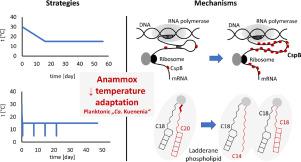Water Research ( IF 12.8 ) Pub Date : 2021-11-18 , DOI: 10.1016/j.watres.2021.117822 Kouba V 1 , Vejmelkova D 2 , Zwolsman E 3 , Hurkova K 4 , Navratilova K 4 , Laureni M 3 , Vodickova P 5 , Podzimek T 5 , Hajslova J 4 , Pabst M 3 , van Loosdrecht McM 3 , Bartacek J 2 , Lipovova P 5 , Weissbrodt Dg 3

|
Anammox bacteria enable efficient removal of nitrogen from sewage in processes involving partial nitritation and anammox (PN/A) or nitrification, partial denitrification, and anammox (N-PdN/A). In mild climates, anammox bacteria must be adapted to ≤15 °C, typically by gradual temperature decrease; however, this takes months or years. To reduce the time necessary for the adaptation, an unconventional method of ‘cold shocks’ is promising, involving hours-long exposure of anammox biomass to extremely low temperatures. We compared the efficacies of gradual temperature decrease and cold shocks to increase the metabolic activity of anammox (fed batch reactor, planktonic “Ca. Kuenenia”). We assessed the cold shock mechanism on the level of protein expression (quantitative shot-gun proteomics, LC HRMS/MS) and the structure of membrane lipids (UPLC
HRMS/MS) and the structure of membrane lipids (UPLC HRMS/MS). The shocked culture was more active (0.66±0.06 vs 0.48±0.06 kg-N/kg-VSS/d) and maintained the relative content of N-respiration proteins at levels consistent levels with the initial state, whereas the content of these proteins decreased in gradually acclimated culture. Cold shocks also induced a more efficient expression of potential cold shock proteins (e.g. ppiD, UspA, pqqC), while putative cold shock proteins CspB and TypA were upregulated in both cultures. Ladderane lipids characteristic for anammox evolved to a similar end-point in both cultures; this confirms their role in anammox bacteria adaptation to cold and indicates a three-pronged adaptation mechanism (ladderane alkyl length, introduction of shorter non-ladderane alkyls, polar headgroup). Overall, we show the outstanding potential of cold shocks for low-temperature adaptation of anammox bacteria and provide yet unreported detailed mechanisms of anammox adaptation to low temperatures.
HRMS/MS). The shocked culture was more active (0.66±0.06 vs 0.48±0.06 kg-N/kg-VSS/d) and maintained the relative content of N-respiration proteins at levels consistent levels with the initial state, whereas the content of these proteins decreased in gradually acclimated culture. Cold shocks also induced a more efficient expression of potential cold shock proteins (e.g. ppiD, UspA, pqqC), while putative cold shock proteins CspB and TypA were upregulated in both cultures. Ladderane lipids characteristic for anammox evolved to a similar end-point in both cultures; this confirms their role in anammox bacteria adaptation to cold and indicates a three-pronged adaptation mechanism (ladderane alkyl length, introduction of shorter non-ladderane alkyls, polar headgroup). Overall, we show the outstanding potential of cold shocks for low-temperature adaptation of anammox bacteria and provide yet unreported detailed mechanisms of anammox adaptation to low temperatures.
中文翻译:

通过逐渐驯化和冷激使厌氧氨氧化菌适应低温:蛋白质表达、膜组成和活性的区别
厌氧氨氧化细菌能够在涉及部分亚硝化和厌氧氨氧化 (PN/A) 或硝化、部分反硝化和厌氧氨氧化 (N-PdN/A) 的过程中有效地从污水中去除氮。在温和气候下,厌氧氨氧化菌必须适应≤15°C,通常是通过逐渐降温;然而,这需要数月或数年的时间。为了减少适应所需的时间,一种非常规的“冷冲击”方法很有前景,包括将厌氧氨氧化生物量长时间暴露在极低的温度下。我们比较了逐渐降温和冷冲击增加厌氧氨氧化酶代谢活性的功效(分批补料反应器,浮游生物“ Ca. Kuenenia”)。我们评估了蛋白质表达水平的冷休克机制(定量霰弹枪蛋白质组学,LC HRMS/MS) 和膜脂的结构 (UPLC)
HRMS/MS) 和膜脂的结构 (UPLC) HRMS/MS)。休克培养物更活跃(0.66±0.06 vs 0.48±0.06 kg-N/kg-VSS/d)并且将N-呼吸蛋白的相对含量保持在与初始状态一致的水平,而这些蛋白的含量降低在逐渐适应的文化中。冷休克还诱导了潜在冷休克蛋白(例如 ppiD、UspA、pqqC)的更有效表达,而推定的冷休克蛋白 CspB 和 TypA 在两种培养物中均上调。厌氧氨氧化所特有的拉德烷脂质在两种培养物中进化到相似的终点;这证实了它们在厌氧氨氧化细菌适应寒冷中的作用,并表明了三管齐下的适应机制(梯烷烷基长度,引入更短的非梯烷烷基,极性头基)。全面的,
HRMS/MS)。休克培养物更活跃(0.66±0.06 vs 0.48±0.06 kg-N/kg-VSS/d)并且将N-呼吸蛋白的相对含量保持在与初始状态一致的水平,而这些蛋白的含量降低在逐渐适应的文化中。冷休克还诱导了潜在冷休克蛋白(例如 ppiD、UspA、pqqC)的更有效表达,而推定的冷休克蛋白 CspB 和 TypA 在两种培养物中均上调。厌氧氨氧化所特有的拉德烷脂质在两种培养物中进化到相似的终点;这证实了它们在厌氧氨氧化细菌适应寒冷中的作用,并表明了三管齐下的适应机制(梯烷烷基长度,引入更短的非梯烷烷基,极性头基)。全面的,



























 京公网安备 11010802027423号
京公网安备 11010802027423号